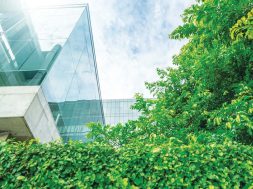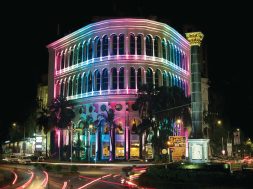Thermal insulation is one of the major elements in green building. It has direct impact on the energy efficiency of building envelope. Any heat exchange through building envelope (e.g. roof and wall) can be sufficiently retarded by applying insulation with right volume and property. It helps to maintain the temperature of indoor environment while minimising AC load and ongoing energy consumption. Most of the credit points available in LEED India NC issued by IGBC come under the credit title named Optimum Energy Performance. An independent study conducted by Winrock over the course of one year demonstrated average energy saving of 22 per cent by insulating external wall and roof with insulation. In summer the energy saving from insulation was as high as 53 per cent. Glasswool is one of the most eligible and time tested material which can be applied to optimise energy performance efficiently.There are other sustainable benefits for using fibreglass wool in green building. The points are discussed below:
Raw materials of glass wool are not depleting environmental resourcesThe primary raw materials for fibreglass wool are not based on dear fossil fuel. It is sand or silica which is rapidly renewable and abundant in nature. As it is basically made out of C class glass fibre, the waste glasses can also be recycled in the process of glasswool manufacturing.
Energy savings through fibreglass wool: building insulationThe life cycle analysis of glasswool product shows that the energy saved during the use of products may be around 700 times higher than the energy used in their production.
Fibreglass wool has low thermal conductivity values and so it gives high thermal resistance in lower thickness. The following system details comply ECBC-2007 which is also one of the basic references for LEED India NC. As per the energy study conducted at U.P. Twiga’s Sikandrabad factory, it has been noted that air conditioning energy requirement in a single room can be cut down up to 53 per cent in summer by using fibreglass wool roof and wall insulation together.
Use, reuse and maintenanceAs a number of buildings require expansion, remodelling or renovation it is advisable to use materials which have some reusability. Fibreglass wool can be reused or removed easily and actually put back in place. There are other insulating materials which require chiselling or other mechanical efforts to reclaim from the existing system and some insulation is actually loss in the process. Also fibreglass wool does not require any maintenance.
RecyclabilityFibreglass wool can be recycled. The in-process trimming scraps are routinely recycled in manufacturing plant and converted to usable product.
Local manufacturing and transportation In India, U.P. Twiga has two plants strategically located near Delhi and near Mumbai to cater entire country’s demand in the least possible time. Moreover glasswool can be compressed thereby taking less space in transporting in containers and trucks reducing the environmental impact of transportation and hence more materials can be supplied to the project site thereby saving transportation energy. It also produces less packing scraps at site.
Glasswool has both thermal and acoustic propertiesGet benefit of energy efficient thermal insulation system while maintaining acoustic comfort. This is possible with glass wool. A high NRC (more than 0.7, for all products) and STC (average 36 dB) value of glass wool restrict reverberation from acoustically designed wall and roof and also cut down dB level sufficiently. There are acoustic ceiling tiles and also acoustic board (for acoustic sensitive applications) made out of high density fibreglass wool.
Other general benefits for fibreglass wool• Non combustible and fire safe material: Glass wool conforms to all the stringent fire standards including BS 476 (part 4, 5, 6 and 7). It is Class 1 as per part 7, i.e. surface spread of flame is nil; Class O as per part 6 and 7 together. Fire propagation main index ‘I’ is less than 12 and sub-index ‘i1’ is less than 6. Moreover it is Class P (not easily ignitable) as per part 4 and non combustible as per part 5. • Glasswool is a non toxic material. It is being used widely in marine, railways and other transport industries due to its low toxicity index and low smoke emission. These are very significant when we consider the safety of building occupants.
• Glasswool is free from any kind of impurities like sulphur, chloride and shots. Its pH value is around 8 which shows it is very much neutral and do not react with other metals. It is totally non-corrosive and has high self life.
In view of the above, Fibreglass wool insulation can be considered as the most suitable insulation material for green buildings.n
Authored by__
Biswajit Roy, Manager Building Solutions, U.P. Twiga Fiberglass Limited
Cookie Consent
We use cookies to personalize your experience. By continuing to visit this website you agree to our Terms & Conditions, Privacy Policy and Cookie Policy.









